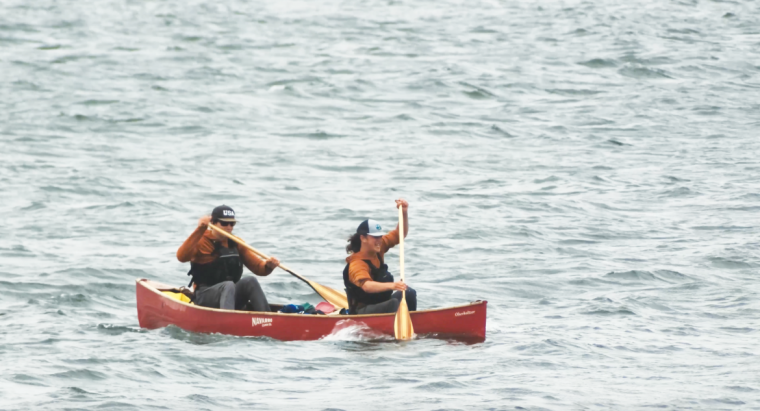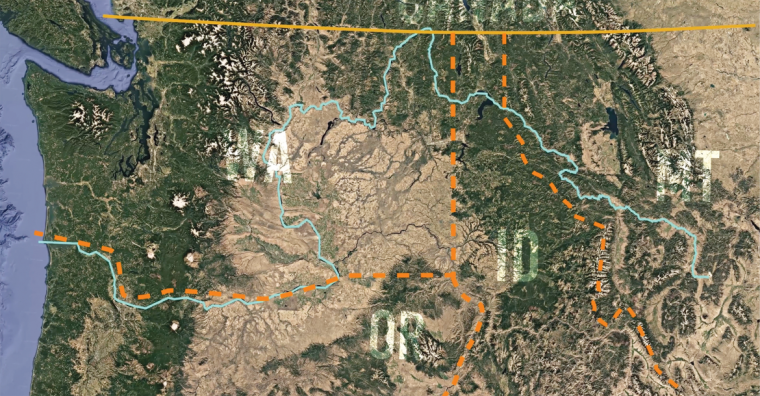
Braxton Mitchell (l) Robert Lester (r) Paddling in Film Columbia River Canoe Project
Butte, Montana Man Partners with Rock Island, Illinois Canoe Manufacturer for 1,300-Mile River Expedition and Award-Winning Documentary Screening April 9 and 16 in Davenport, Iowa
For a guy who goes by “Mountain King” online, Robert Lester finds it a bit “crazy” that he’s become known for canoeing – particularly since he’s set foot in a canoe only once since an epic 52-day canoe trip in 2023.
Then again, once Lester had mapped out the logistics and secured a canoe sponsor, it would have been crazy not to attempt an adventure of a lifetime. That adventure saw Lester and his cousin traverse five waterways from the Continental Divide near Butte, Montana, to the Pacific Ocean, documenting the journey for a documentary, The Columbia River Canoe Project.
“It is really interesting to be known as a canoer, because I know there are a lot of crazier canoers out there,” Lester said. “But this has been the largest expedition of my life and one of my greatest accomplishments – not just the trip, but also getting this film together – and I’m really so honored.”
Inspired by His Quadriplegic Friend's Challenge
Growing up in Butte, Lester sought out adventure in the mountains rather than on flatter ground (or water). By early adulthood, Lester had racked up accomplishments as a mountaineer and skier, documenting some of his feats with the help of friends.
Whenever he grew bored during a physics lecture at Montana State University, Lester would sketch out skiing or climbing trips. But having exhausted ideas, he one day considered a different type of adventure he’d wanted to do since childhood: using the interconnected river system of the western U.S. as a highway to travel to the ocean.
By the time the lecture ended, Lester had the makings of a plan even if he didn’t necessarily plan to pursue it. A while later, Lester was talking with a friend who is quadriplegic and has an “infectious positive attitude” and mentioned the idea of the coastal expedition by canoe.
“He just lit up and said, ‘Man, you got to do that,’” Lester recalled. “For me, that meant I really had to do it.”
The next day, Lester e-mailed every canoe maker in the country, laying out his plans for the expedition and documentary. Even though he didn’t have much to show in terms of prior canoeing experience, Lester’s request was simple: “Take a chance on me.”
Navarro Canoe Co., based in Rock Island, Illinois, took that chance, and offered up a Bob Foote designed, 17-foot Ruby Red “Oberholtzer” expedition grade canoe. By October 2022, the adventure was on. (That same month, the Reader published Bruce Walters' "Buried Stories" essay about Iowa native Ernest Oberholtzer. “Ober” was born in 1884 and buried in 1977, both in Davenport, Iowa. Among other feats, he was a wilderness canoeist, founding member of the Wilderness Society, and helped preserve the Quetico Boundary Waters.)
Handcrafted Canoe
But there was a not-so-insignificant task that needed to be done before Lester could set off on his adventure: Jeff O’Hern, the master craftsman at Navarro Canoe, needed to hand-build a custom canoe for Lester.
When Lester’s “take a chance on me” request came in, O’Hern was on the receiving end, and the two men spent about an hour talking about the trip. It was quickly evident to O’Hern, who was a youth pastor for 20-plus years and a Moline High School football coach, that Lester had a genuine care and concern for the environment, and was also serious (and seriously excited) about making the adventure a reality.
“I liked the idea of what he was thinking of doing,” said O’Hern, who is likewise an adventurer but wouldn’t attempt a similar expedition now, at the age of 65. “It became real clear to me that he was onto something.”
O’Hern took the idea to his partners, who had fairly recently purchased Navarro, and they collectively decided: “Well, why not?”
Then came the real work: While the standard Navarro canoes are made for flat water conditions, such as ponds or streams, O’Hern had to engineer a “boat that could go through it all,” including rapids and rocks. Drawing on some of his past canoe adventures and researching the route Lester would take, O’Hern engineered a thicker hull and added extra protection in various areas, including the gunwales, deck, and seats, and lined the canoe with industrial-strength kevlar to make it puncture-proof.
Trying to keep the weight down was also a factor, given the need to portage at various points. “There’s a fine line between what’s enough and what’s too much,” O’Hern said.
The end result was a customized Navarro-X Factor canoe that was about 14 pounds over the standard weight and would’ve cost more than $10,000, versus the $7,900 standard price. It took about 110 to 120 hours to complete the build, O’Hern said, which was a little longer than expected and meant the canoe arrived in Montana just in time for casting off.
“It was really hairy,” he recalled. “It was really a close one.”

Cousin as Co-Pilot
As the trailer for the 70-minute, award-winning documentary alludes to, an adventure of a lifetime is bound to be life-changing, if, at times, fraught. While the film details some of the drama along the way – think: whitewater rapids and a nasty case of trench foot – it was what happened before Lester ever dipped a paddle in the water that really rocked the boat. (The film has been screened dozens of times all over the northwest states, British Columbia, Minnesota, and now Iowa. Festival awards include 2024 Best Environmental Documentary at the LA International Art Film Festival.)
Only a few weeks before his planned departure in mid-May 2023, Lester learned that the two buddies he’d banked on joining him to the Pacific Ocean couldn’t make it after all.
That’s when Lester’s cousin, Braxton Mitchell, came into the picture. Mitchell had just graduated from high school – “the kid’s never been on any adventure before,” as Lester put it – but he was game to come along, and that was qualification enough.
Mitchell’s involvement, Lester said, gave the film a whole other, inspirational quality. In addition to detailing their journey and the ecological issues facing the Columbia River Watershed, the film is a coming-of-age story of sorts.
“That was really something that was unpredictable, but incredibly fortunate,” Lester added.

That unpredictable-yet-fortunate combination is apt for most everything associated with the project. Thanks to the four filmmaker friends who trailed along following the cousins, who were 25 and 18 at the time, viewers feel like they’re along for a ride that might have tested people far more experienced; Mitchell had never been in a canoe before, and Lester said his experience wasn’t much to tout, either.
By virtue of editing the documentary and now attending film festivals around the country, where the film has racked up award after award, Lester has revisited that journey hundreds of times. But he also gets to appreciate it anew through the eyes of viewers.
And, it seems, not everyone is confident that the cousins will make it to the Pacific Ocean.
“There’s both this sense that people are really excited we made it and relieved,” Lester said. “The audience seems to love this chaos of us making it to the end.”
An Undercurrent of Inspiration
Making it to the end meant obliging by a self-prescribed rule: The cousins only relied on the canoe or their feet. They portaged more than 175 miles, including 24 miles one day, carrying the canoe in the early summer heat and turning down offers of rides from curious passerby.
The cousins started on Silver Bow Creek near Butte which took them to the Clark Fork River, then Lake Pend Oreille, then Pend Oreille River, the Columbia River and, finally, to the Pacific Ocean. They passed through cities like Missoula and Portland, as well as some very remote parts of the country.
For someone who has long gravitated to the mountains, Lester was impressed by the views he got to appreciate from his seat in the canoe. “I was blown away by how much beauty was around every corner.”
Lester has likewise been blown away by how well-received the documentary has been by audiences and film festival judges across the country.
“We made this film, but I never dreamed it would ever have the incredible reception it has,” Lester said. “People are so excited about the trip.”
What seems to resonate, Lester said, is an undercurrent of inspiration that runs throughout the entire project – from the friend who inspired him to chase a childhood dream to the people who come up after a screening to recount their own adventures to those people who may leave a theater feeling a bit more inspired than when they arrived.

The Journey Continues
Even though the expedition ended almost two years ago, the journey continues. While Lester said he doesn’t have “a great answer” to an oft-asked question of what’s next, for now he’s focused on the film.
The film has also boosted business for Navarro Canoe Co., which built less than 20 canoes in 2024. O’Hern said there’s been an uptick in inquiries since the film began showing in the Quad Cities this year, and two custom builds currently underway came about because of the company’s involvement with the film.
These custom builds, O’Hern said, are “really fun,” because the Navarro crew collaborates with the future owner and handcrafts the canoe according to their target experience. And all of this “unexpected fun” around the Columbia River Canoe Project came about because of one conversation, he added. “The whole thing has been a good little adventure.”
Since the documentary first premiered in Butte, Montana, in August 2024, Lester has been learning as he goes, something he’s well-versed in now, including how to promote the documentary, arrange showings, and enter film festivals.
Details about past and upcoming screenings and awards nationwide can be found at Lester’s Web site: Mountain-King-Industries.com/columbia-river-canoe-project. Among the film's creative talent are: Neil Larson, director of photography / co-editor; Orion Herman, lead aerial DP / co-editor; Ben Kaden, cinematographer; and Jonathan Stone, lead photographer.
Navarro Canoe Co. has been hosting weekly screenings that began in mid-March and will be shown Wednesday, April 9, and Wednesday, April 16, at the The Last Picture House just across the river from Rock Island, Illinois, in downtown Davenport, Iowa. Lester will be on site in the Quad Cities for the April 16 screening.
Longer-term, Lester's goal is to sell the documentary so it can be made available through a streaming service.
The turn his life has taken in recent years is still a bit surreal for Lester. He never thought the film would play in more than a handful of theaters, let alone take him all across the country for screenings and film festivals.
“I'm really lucky to live an outdoor life and to get to tell these stories,” Lester said.
This article was first published at CowboyStateDaily.com/2025/03/30/butte-mans-epic-canoe-trip-from-montana-to-the-pacific-made-into-movie/.








